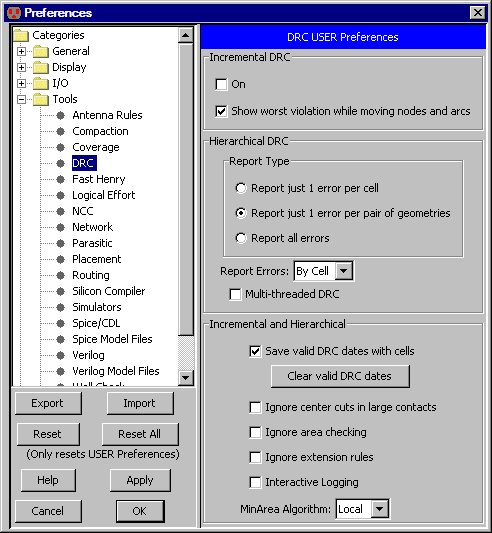9-2-2: DRC Preferences |
9-2-2: DRC Preferences |
|
To control the DRC,
use the DRC Preferences (in menu File / Preferences..., "Tools" section, "DRC" tab).
By default, the incremental design-rule checker is on. To turn it off, uncheck the "On" checkbox in the "Incremental DRC" section. You can also control the incremental display of design-rule violations that occurs when moving nodes and arcs (see Section 2-4-1). |  |
There are three levels of checking that can be requested for the Hierarchical DRC. Each level of checking consumes more time and finds more errors.
Hierarchical errors appear in the cell explorer (see Section 4-5-2). Since there can be many errors involving many different rules, you can control how they appear by setting "Report Errors" to:
Users with multiprocessor computers can check "Multi-threaded DRC" to speed-up the hierarchical design-rule checking process.
The design-rule checker remembers the date of the last clean check. If a cell has not changed since then, it does not need to be rechecked. This date information can be stored in the libraries (requiring them to be saved) or can be held only in Electric's memory (requiring them to be rechecked if Electric is restarted). You can also request that all date information be removed so that a full recheck is done. To see which cells have passed DRC, use the General Cell Lists... command (in menu Cell / Cell Info) A "D" is shown in on the right for cells that are DRC current (see Section 3-7-1).
MOS contact nodes automatically increase the number of cuts when they grow larger (see Section 7-4-1). Because of this, very large contact nodes can create excessive work for the design-rule checker as it examines each of the cuts. To save time, check the "Ignore center cuts in large contacts" check box, which will examine only the cut layers around the edges of contact nodes.
DRC rules for new technologies might require special rules, which can be time consuming. To ignore these errors, check "Ignore area checking" (for minimum area rules) and "Ignore extension rules" (for special overlap rules).
After DRC is complete, errors are available in the the cell explorer. If you wish to see errors while DRC is running, check "Interactive logging", and the errors will appear incrementally.
The final DRC control is how minimum area detection is done. Setting "MinArea Algorithm" to "Simple" uses an algorithm that is slower. Setting "MinArea Algorithm" to "Local" uses an algorithm that is faster but consumes more memory.
| Previous | Table of Contents | Next |